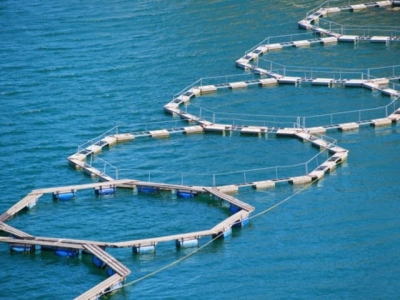Optimal tryptophan levels boost tilapia weight gain, amino acid uptake

Boosting dietary tryptophan amounts also bumps weight gain, amino acid retention for Nile tilapia eating corn-soy diet, say researchers.
A group of researchers from several universities in Brazil examined the levels of the limiting amino acid tryptophan needed to support use of a corn and soybean meal-based diet in juvenile Nile tilapia. The group published its results in the journal ofAnimal Feed Science and Technology.
“The objective of this study was to determine the dietary tryptophan (Trp) requirements to optimize growth performance of juvenile Nile tilapia,” said the researchers.
Based upon analysis of dietary Trp levels in the trial diets and weight gain, feed conversion, protein efficiency, fish uniformity and whole body retention of arginine, phenylalanine and lysine the optimal amount of Trp was established as 2.9g/kg, they said.
“In conclusion, 2.9 g/kg of Trp meets the dietary requirements for growth performance of juvenile Nile tilapia fed corn-soybean meal diets,” said the researchers. “Dietary Trp increases fish uniformity and amino acids retention.”
Why tryptophan levels?
The largest and most expensive portion of a fish feed is the protein component, said the researchers. But adequate amounts of amino acids (AA) are needed for fish growth, health and survival.
Finding, and meeting the optimal requirements of specific AA is necessary to improve the cost effectiveness of diets, they said. If amounts of dietary amino acids are low, use of remaining nutrients will be impaired along with protein synthesis and other physiological processes.
Functional AA regulate important metabolic pathways that control maintenance, growth, reproduction and immune responses for fish, they said. Tryptophan is both an essential and functional AA linked to niacin synthesis and acting as a precursor of the neurotransmitter serotonin.
“Dietary supplementation of Trp is associated with suppressed aggression and cannibalism,” the researchers said.
The potential influence of Trp on fish uniformity has received little attention, they said. However, it could be useful for improving feed management and industrial production of the species.
Although work has been done to define some optimal AA levels, much of that focus has been on methionine and lysine, they said. And, as corn and soybean meal have replaced a large amount of fish meal, more crystalline amino acids have been added to meet fish dietary needs.
“However, although tilapia has been cultivated under various environmental conditions in recent years, the dietary Trp requirements have yet to be established for this species considering fish uniformity,” said the researchers. “Since tilapias form hierarchal groups resulting in large variation in size that impairs feed management and growth performance.”
Study details
In the feeding trial, 180 juvenile tilapia were given one of five diets for 60 days, said the researchers. The diets included increasing levels of dietary Trp at 1.8, 2.3, 2.7, 3.2 and 3.7g/kg.
The diet including the 1.8g/kg of Trp was considered the basal diet, they said.
A sample of fish were collected at the start of the feeding trial, they said. Additional fish were harvested at the end of the process to allow for body composition analysis.
Additionally, growth performance metrics were calculated including body weight gain, the feed conversion ratio, survival rate, protein efficiency ratio, AA retention and fish uniformity, said the researchers. Fish also were checked for dry matter levels, crude protein, crude lipid and mineral matter.
Results
Fish body weight gain was highest for fish getting the diet with 2.7g/kg of Trp, said the researchers. Feed intake was best for fish getting diets with 2.3 or 2.7g/kg Trp and the feed conversion was best for fish getting the diets with 2.7 or 3.2g/kg of the amino acid.
“The relationship between body weight gain, feed conversion ratio, protein efficiency ratio, and fish uniformity against dietary Trp levels could be expressed as a second-order polynomial regression analysis, where the best Trp levels were estimated to be 2.9, 3.1, 3.1, and 2.9 g/kg, respectively,” they said. “Whole body retentions of arginine, phenylalanine, and lysine were highest in fish fed 3.0, 3.1, and 3.1 g/kg Trp, respectively.”
“According to quadratic regression analysis between fish uniformity and dietary Trp level, the requirement for fish uniformity was estimated at 2.9 g/kg,” the researchers said. The different diets had no influence on whole body composition, they added.
“No external pathological or aggressive behaviors signs were observed, even in fish fed the lowest Trp level,” they said. Mortality was low, and fish deaths were not connected to the feeding trial, they added.
Có thể bạn quan tâm
 Organic selenium use boosts farmed fish health with oxidative stress challenge
Organic selenium use boosts farmed fish health with oxidative stress challenge Long-term organic selenium supplementation may boost immune responses from farmed pacu without undermining weight gain, say researchers.
 Juvenile brown trout see benefit from veggies in diet
Juvenile brown trout see benefit from veggies in diet Plant-derived proteins can partially replace dietary fishmeal for farmed brown trout and maintain growth performance, say researchers.
 How much vitamin A should silver catfish take?
How much vitamin A should silver catfish take? Boosted vitamin A levels support growth, production of silver catfish, say researchers. How much vitamin A should silver catfish take?